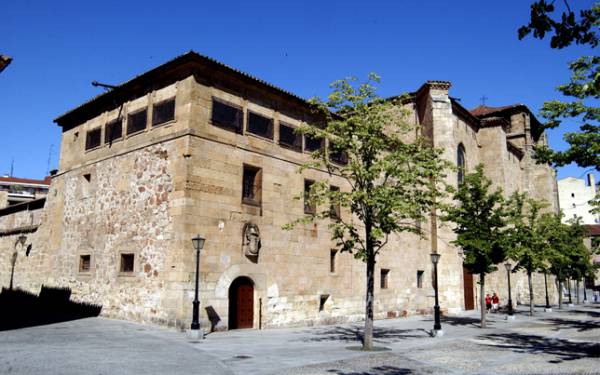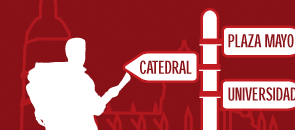Las Dueñas Convent
Since being founded in 1419, the nuns from this convent have dedicated their whole lives to prayer, study and work. The magnificent cloister that it houses, as well as being a pleasure to behold, attests to this life of retreat, of inner peace.
Address: Plaza del Concilio de Trento
Telephone: 923 21 54 42
Price: Tickets: 2 Euros / 1 Euro groups (of over 20)
Casa de Santa Teresa
Santa Teresa lived in what used to be one of its foundations for four years. There, she faced her fears and on the stairwell, its chapel, its cell, its poverty, its courtyard, where she was inspired to write her renowned poem “vivo sin vivir en mí” (I live without living within myself).
Address: Casa de Santa Teresa
Telephone: 923 21 70 23
Price: Tickets: Donations
The Ursulines Convent
The convent was founded in the middle of the 15th century by Alfonso de Fonseca and Lady Sancha Maldonado, the first nun at the monastery. Since 1992, it has been the residence of nuns from the closed order of Santa Clara.
In the church choir is the beautiful coffered ceiling, a fusion of Italian and mudejar styles as well as the altarpieces by Juan de Borgoña (16th century).
Address: Calle Las Úrsulas 2
Telephone: 923 21 98 77
Price: Tickets: 2 Euros. Closed the last Sunday of each month.
San Benito Church
The parish church of San Benito was built in about 1104 on the site of the former Romanesque church, in the area resettled by the Galicians. The church has close ties to the Salamancan nobility and was the headquarters of one of the city’s largest factions: the benitinos. During the 13th and 14th centuries, the nobility found itself split into two opposing factions fighting for the control of the city and the lands surrounding it: San Benito and Santo Tomé. It was a period of cruelty and reprisals involving the whole city, but which came to an end, thanks to the mediation efforts of San Juan de Sahagún, the Patron Saint of the city.
The church was renovated in 1506 by Maldonado y Acevedo. Inside is the main family vault. The facade and exterior buttresses bare the coat of arms of the two family names.
San Marcos Church
Built just next to the new city wall in 1178, next to the Zamora Gate in the Castilian district of the city. In 1202, Alfonso IX put the church together with the Corral de San Marcos, as well as lands, vineyards, houses and farmyards under the protection of the cabildo or town council, with the condition that they pray for the souls of the Kings of Leon. In addition to the round construction being very uncommon at that time, what is even more surprising is the interior, with three apses and three naves, as if it were a basilica. In 1968 during the renovation of the church, workers discovered some 14th Century murals, a Romanesque church altar hidden behind an altarpiece, and a Gothic Christ which presides over the main altar.
San Martín Church
The founding of this church in 1103 can be attributed to the head of the resettlement of the “toreses” area of the city, Martín de Fernández. Since medieval times, it has been considered the trading and commercial area of the city. Prior to the construction of the Plaza Mayor, the shops and markets were located near the church. During the latter part of the middle ages, the church porch was served a political purpose, it was used to host the meetings of the Council, and its bell marked the start of any major event in the city: the meeting of the Council, the setting up of the merchants’ stalls, the celebration of festivals and bull fighting.
The south-facing door, the most decorated one, which can only be viewed from inside – given that the church has been greatly renovated - has an eye-catching design depicting the working calendar and the months, the only one of its kind in Salamanca.
Santiago Church
Restored in 1957, it is a perfect example of mudéjar, religious architecture which has an air of Moraña about it, but which is quite different from the original. It was the parish church of the Mozarabic quarter until the continued growth of the Tormes River forced this community to move to different parts of the old city and the former Christian rites were abandoned. It then became the church of the millers, the tanners, the fishermen and other humble professions that sought a living along the banks of the river.
Santo Tomás Cantuariense Church
Located in the former Portogalo (Portuguese) district, the church, which pays homage to British Saint Thomas Becket, Archbishop of Canterbury, was founded by English brothers Ricardo and Randulfo, involved in the design of the Cathedral.
The idea of using churches to resettle areas of the city is expressed by way of a curious capital atop the main arch which depicts a battle between two horsemen: on one hand, the victor, a Christian nobleman carrying a Normand shield, the loser, a Muslim showing black physical traits. Outside, there are some very attractive decorative elements on the traditionally Visigoth windows.
San Juan Bautista de Barbalos Church
Its name goes back to its very founding, in the Castilian district, by the Knights of the order of San Juan of Jerusalem in 1139.
Decoratively speaking, one of the highlights is the cornice of the chevet which is held aloft by ornamental hounds with faces, animal heads and a musical scenario comprising a rabel (ancient three stringed instrument played with a bow) player, another musician playing a small drum and a dancer performing a leap.
- Perpendicular to the church is Calle de los Perdones, which gets its name from an incident following an address by San Vicente Ferrer, after which there were so many people wanting to confess, that they filled the entire street.












